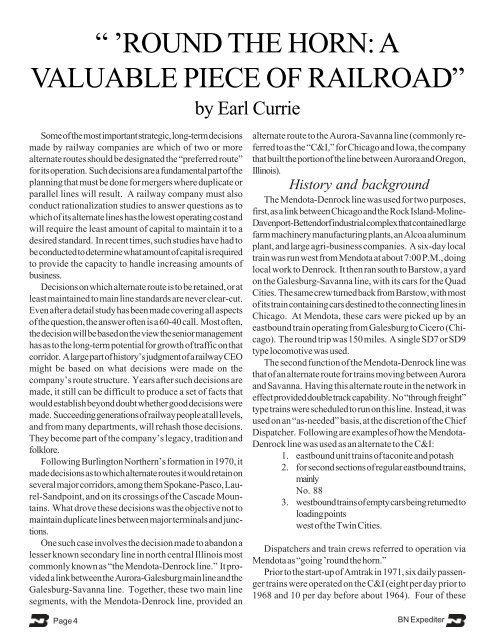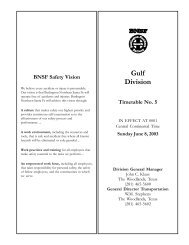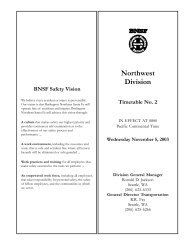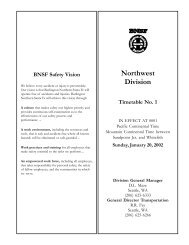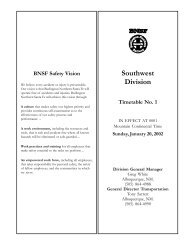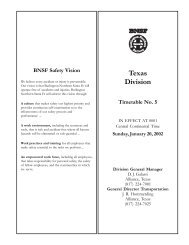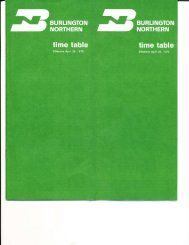“ ’ROUND THE HORN: AVALUABLE PIECE OF RAILROAD”by Earl CurrieSome <strong>of</strong> <strong>the</strong> most important strategic, long-term decisionsmade by railway companies are which <strong>of</strong> two or morealternate routes should be designated <strong>the</strong> “preferred route”for its operation. Such decisions are a fundamental part <strong>of</strong> <strong>the</strong>planning that must be done for mergers where duplicate orparallel lines will result. A railway company must alsoconduct rationalization studies to answer questions as towhich <strong>of</strong> its alternate lines has <strong>the</strong> lowest operating cost andwill require <strong>the</strong> least amount <strong>of</strong> capital to maintain it to adesired standard. In recent times, such studies have had tobe conducted to determine what amount <strong>of</strong> capital is requiredto provide <strong>the</strong> capacity to handle increasing amounts <strong>of</strong>business.Decisions on which alternate route is to be retained, or atleast maintained to main line standards are never clear-cut.Even after a detail study has been made covering all aspects<strong>of</strong> <strong>the</strong> question, <strong>the</strong> answer <strong>of</strong>ten is a 60-40 call. Most <strong>of</strong>ten,<strong>the</strong> decision will be based on <strong>the</strong> view <strong>the</strong> senior managementhas as to <strong>the</strong> long-term potential for growth <strong>of</strong> traffic on thatcorridor. A large part <strong>of</strong> history’s judgment <strong>of</strong> a railway CEOmight be based on what decisions were made on <strong>the</strong>company’s route structure. Years after such decisions aremade, it still can be difficult to produce a set <strong>of</strong> facts thatwould establish beyond doubt whe<strong>the</strong>r good decisions weremade. Succeeding generations <strong>of</strong> railway people at all levels,and from many departments, will rehash those decisions.They become part <strong>of</strong> <strong>the</strong> company’s legacy, tradition andfolklore.Following <strong>Burlington</strong> Nor<strong>the</strong>rn’s formation in 1970, itmade decisions as to which alternate routes it would retain onseveral major corridors, among <strong>the</strong>m Spokane-Pasco, Laurel-Sandpoint,and on its crossings <strong>of</strong> <strong>the</strong> Cascade Mountains.What drove <strong>the</strong>se decisions was <strong>the</strong> objective not tomaintain duplicate lines between major terminals and junctions.One such case involves <strong>the</strong> decision made to abandon alesser known secondary line in north central Illinois mostcommonly known as “<strong>the</strong> Mendota-Denrock line.” It provideda link between <strong>the</strong> Aurora-Galesburg main line and <strong>the</strong>Galesburg-Savanna line. Toge<strong>the</strong>r, <strong>the</strong>se two main linesegments, with <strong>the</strong> Mendota-Denrock line, provided anPage 4alternate route to <strong>the</strong> Aurora-Savanna line (commonly referredto as <strong>the</strong> “C&I,” for Chicago and Iowa, <strong>the</strong> companythat built <strong>the</strong> portion <strong>of</strong> <strong>the</strong> line between Aurora and Oregon,Illinois).History and backgroundThe Mendota-Denrock line was used for two purposes,first, as a link between Chicago and <strong>the</strong> Rock Island-Moline-Davenport-Bettendorf industrial complex that contained largefarm machinery manufacturing plants, an Alcoa aluminumplant, and large agri-business companies. A six-day localtrain was run west from Mendota at about 7:00 P.M., doinglocal work to Denrock. It <strong>the</strong>n ran south to Barstow, a yardon <strong>the</strong> Galesburg-Savanna line, with its cars for <strong>the</strong> QuadCities. The same crew turned back from Barstow, with most<strong>of</strong> its train containing cars destined to <strong>the</strong> connecting lines inChicago. At Mendota, <strong>the</strong>se cars were picked up by aneastbound train operating from Galesburg to Cicero (Chicago).The round trip was 150 miles. A single SD7 or SD9type locomotive was used.The second function <strong>of</strong> <strong>the</strong> Mendota-Denrock line wasthat <strong>of</strong> an alternate route for trains moving between Auroraand Savanna. Having this alternate route in <strong>the</strong> network ineffect provided double track capability. No “through freight”type trains were scheduled to run on this line. Instead, it wasused on an “as-needed” basis, at <strong>the</strong> discretion <strong>of</strong> <strong>the</strong> ChiefDispatcher. Following are examples <strong>of</strong> how <strong>the</strong> Mendota-Denrock line was used as an alternate to <strong>the</strong> C&I:1. eastbound unit trains <strong>of</strong> taconite and potash2. for second sections <strong>of</strong> regular eastbound trains,mainlyNo. 883. westbound trains <strong>of</strong> empty cars being returned toloading pointswest <strong>of</strong> <strong>the</strong> Twin Cities.Dispatchers and train crews referred to operation viaMendota as “going ’round <strong>the</strong> horn.”Prior to <strong>the</strong> start-up <strong>of</strong> Amtrak in 1971, six daily passengertrains were operated on <strong>the</strong> C&I (eight per day prior to1968 and 10 per day before about 1964). Four <strong>of</strong> <strong>the</strong>seBN Expediter
trains were “bunched” in <strong>the</strong> early afternoon. No. 97 (aChicago-Twin Cities train carrying forwarder merchandiseto connect with Great Nor<strong>the</strong>rn and Nor<strong>the</strong>rn Pacific trains)was <strong>of</strong>ten run via Mendota to relieve congestion until <strong>the</strong> early1960’s, when its schedule had to be tightened for competitivereasons. From <strong>the</strong>n on, No. 97 was operated only on <strong>the</strong>C&I.Heavy tonnage eastbound trains were normally operatedvia Mendota-Denrock to get <strong>the</strong>m out <strong>of</strong> <strong>the</strong> way <strong>of</strong> <strong>the</strong>priority trains scheduled to run on <strong>the</strong> C&I. While <strong>the</strong>maximum grade was 0.8 per cent on both lines, <strong>the</strong> overallgrade pr<strong>of</strong>ile was much more favorable on <strong>the</strong> Mendota-Denrock route. A look at <strong>the</strong> pr<strong>of</strong>ile for <strong>the</strong> C&I showsgrades <strong>of</strong> 0.8 per cent at several locations, but only at onelocation on <strong>the</strong> Mendota-Denrock line. Most <strong>of</strong> <strong>the</strong> heavyeastbound trains were not given enough power to get over <strong>the</strong>0.8 per cent grades without having to “double <strong>the</strong> hill.” With<strong>the</strong> practice <strong>of</strong> not operating more than one train at a timebetween Mendota and Denrock, having <strong>the</strong> main track tiedup from one to two hours for doubling would not delay o<strong>the</strong>rtrains, or cause congestion on <strong>the</strong> line.During Ralph Budd’s time as President <strong>of</strong> <strong>the</strong> <strong>Burlington</strong>in <strong>the</strong> 1930’s, line changes were made on <strong>the</strong> C&I to reducecurvature. These improvements were needed to allow higherspeeds <strong>of</strong> 90 and 100 MPH for <strong>the</strong> new Zephyr passengertrains put in service at that time. However, no programs forgrade reduction or to take out <strong>the</strong> numerous sags betweenStratford and Savanna were undertaken. From his experienceon <strong>the</strong> Great Nor<strong>the</strong>rn Railway, Mr. Budd would havebeen familiar with <strong>the</strong> benefits from such improvements, e.g.,<strong>the</strong> line improvements made on <strong>the</strong> GN’s Willmar line and <strong>the</strong>Minot-Williston line, both <strong>of</strong> which had characteristics quitesimilar to <strong>the</strong> west end <strong>of</strong> <strong>the</strong> C&I. With <strong>the</strong> alternate routevia Mendota being available for heavy freight trains, it may bethat improving <strong>the</strong> C&I for <strong>the</strong> operation <strong>of</strong> freight trains wasnot considered a priority at that time.Since <strong>the</strong>se trains operated on a water level grade for <strong>the</strong>entire 265 miles from St. Paul to Savanna, it would have beenuneconomic to add power to <strong>the</strong>se trains at Savanna, to getover <strong>the</strong> 0.8 per cent grades on <strong>the</strong> C&I without doubling.For example, a taconite or potash train <strong>of</strong> about 12,000 tonswould be powered with three GP30, 35 or 40-type units,with total horsepower <strong>of</strong> about 7500, a ratio <strong>of</strong> only about0.65. By running such trains on <strong>the</strong> Mendota-Denrock line,that favorable, low-cost operation could be maintained east<strong>of</strong> Savanna.The alternate route via Mendota was also used forwestbound trains <strong>of</strong> empty cars being returned to loadingpoints west <strong>of</strong> <strong>the</strong> Twin Cities. Often, a single GP30, 35 or40 locomotive was used on a train <strong>of</strong> 100 to as many as 180BN Expediterempties. This practice kept such slow-moving trains <strong>of</strong>f <strong>the</strong>C&I, and avoided <strong>the</strong> problem <strong>of</strong> sidings being too short forsuch long trains to meet opposing trains on a single-track line.Operating post-merger (1970)Soon after <strong>the</strong> 1970 merger, traffic increased significantlybetween <strong>the</strong> Twin Cities and Chicago. As more and moretrains were run over <strong>the</strong> light rail between Mendota andDenrock, <strong>the</strong> need to upgrade <strong>the</strong> line became apparent. Inaddition to <strong>the</strong> need to relay <strong>the</strong> line with heavier rail, <strong>the</strong> tiecondition was marginal, with a gravel ballast section. Aprogram was needed for installation <strong>of</strong> second-hand 112-lb.or heavier welded rail, tie renewal (about 1,000 ties per mile),and a granite ballast section. In <strong>the</strong> late 1970’s, this workcould have been completed for about $7 million. While it wasagreed by <strong>the</strong> division and <strong>the</strong> system engineering staff thatthis work should be done, it could not compete with <strong>the</strong>overriding priority to put all available resources into upgrading<strong>the</strong> primary corridors experiencing major increases in unitcoal train tonnage.Comparison <strong>of</strong> Line Characteristics(as <strong>of</strong> 1985)DistanceC&I (main line, Aurora-Savanna), 105 milesAurora-Savanna via Mendota-DenrockAurora-Mendota45 milesMendota-Denrock49 milesDenrock-Savanna30 milesTotal: 124 milesGrades (maximum)C&I: 0.8% (at numerous locations)Aurora-Mendota: 0.4% (ascending westbound)Mendota-Denrock: 0.8% (ascending eastbound), 1.0%(ascending westbound)Denrock-Savanna: 0.3% (in both directions)Speed Restrictions (freight trains)C&I : 60 MPH for priority trains; 50 MPH for regular trains;30 MPH for loaded coal, potash and taconite trains.Aurora-Mendota: same as on C&I, except 40 MPH forloaded unit trains.Mendota-Denrock: 40 MPH, except 30 MPH for unit trains.Denrock-Savanna: 49 MPH, except 30 MPH for unit trains.RailC&I: 129-lb. and heavierAurora-Mendota: 129-lb. and heavierMendota-Denrock: 85, 90, 100 and 110-lb.Denrock-Savanna: 100 and 110-lb.Page 5


